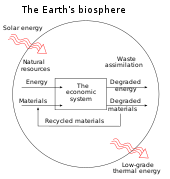 First edition cover | |
| Authors | |
|---|---|
| Language | English |
| Published | 2 March 1972[1] |
| Publisher | Potomac Associates – Universe Books |
| Pages | 205 |
| ISBN | 0-87663-165-0 |
| OCLC | 307838 |
| digital: Digitized 1972 edition | |
| Part of a series on |
| Ecological economics |
|---|
 |
The Limits to Growth (LTG) is a 1972 report[2] that discussed the possibility of exponential economic and population growth with finite supply of resources, studied by computer simulation.[3] The study used the World3 computer model to simulate the consequence of interactions between the Earth and human systems.[a][4] The model was based on the work of Jay Forrester of MIT,[2]: 21 as described in his book World Dynamics.[5]
Commissioned by the Club of Rome, the study saw its findings first presented at international gatherings in Moscow and Rio de Janeiro in the summer of 1971.[2]: 186 The report's authors are Donella H. Meadows, Dennis L. Meadows, Jørgen Randers, and William W. Behrens III, representing a team of 17 researchers.[2]: 8
The report's findings suggest that, in the absence of significant alterations in resource utilization, it is highly likely that there will be an abrupt and unmanageable decrease in both population and industrial capacity. Although it faced severe criticism and scrutiny upon its release, the report influenced environmental reforms for decades. Subsequent analysis notes that global use of natural resources has been inadequately reformed to alter its expected outcome.[b] Yet price predictions based on resource scarcity failed to materialize in the years since publication.
Since its publication, some 30 million copies of the book in 30 languages have been purchased.[6] It continues to generate debate and has been the subject of several subsequent publications.[7]
Beyond the Limits and The Limits to Growth: The 30-Year Update were published in 1992 and 2004 respectively;[8][9] in 2012, a 40-year forecast from Jørgen Randers, one of the book's original authors, was published as 2052: A Global Forecast for the Next Forty Years;[10] and in 2022 two of the original Limits to Growth authors, Dennis Meadows and Jørgen Randers, joined 19 other contributors to produce Limits and Beyond.[11]

- ^ "The Limits to Growth+50". Club of Rome. 2022.
- ^ a b c d Meadows, Donella H; Meadows, Dennis L; Randers, Jørgen; Behrens III, William W (1972). The Limits to Growth; A Report for the Club of Rome's Project on the Predicament of Mankind. New York: Universe Books. ISBN 0876631650. Retrieved 26 November 2017.
- ^ MacKenzie, Debora (4 January 2012). "Boom and doom: Revisiting prophecies of collapse". New Scientist. Retrieved 28 November 2017.
- ^ Edwards, Paul N. (2010). A Vast Machine: Computer Models, Climate Data, and the Politics of Global Warming. MIT Press. pp. 366–371. ISBN 9780262290715.
- ^ Forrester, Jay Wright (1971). World Dynamics. Wright-Allen Press. ISBN 0262560186.
- ^ Cite error: The named reference
Nørgård-2010was invoked but never defined (see the help page). - ^ Farley, Joshua C. "The Limits to growth debate". The University of Vermont. Retrieved 1 December 2017.
- ^ Meadows, Donella H.; Randers, Jorgen; Meadows, Dennis L. (1992). Beyond the Limits. Chelsea Green Publishing. ISBN 0-930031-62-8.
- ^ Meadows, Donella H.; Randers, Jorgen; Meadows, Dennis L. (2004). The Limits to Growth: The 30-Year Update. White River Junction VT: Chelsea Green Publishing Co. ISBN 1931498512. Retrieved 27 November 2017.
- ^ Randers, Jørgen (2012). 2052: A Global Forecast for the Next Forty Years. White River Junction VT: Chelsea Green Publishing Co. ISBN 978-1-60358-467-8. Retrieved 29 March 2019.
- ^ Bardi, Ugo; Alvarez Pereira, Carlos, eds. (2022). Limits and Beyond: 50 years on from The Limits to Growth, what did we learn and what's next? A Report to The Club of Rome. Exapt Press. ISBN 978-1-914549-03-8.
Cite error: There are <ref group=lower-alpha> tags or {{efn}} templates on this page, but the references will not show without a {{reflist|group=lower-alpha}} template or {{notelist}} template (see the help page).